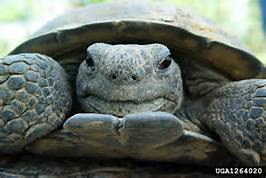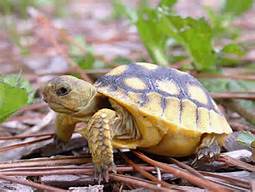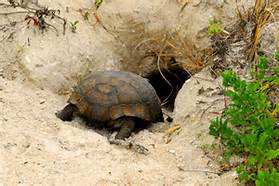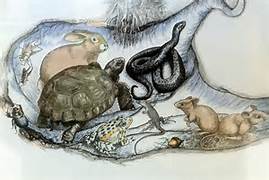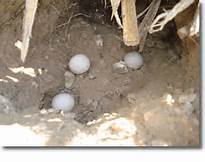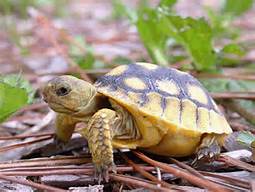Gopher tortoises have a listing designation of “threatened species”, and are protected under federal law. Tortoise burrows on a vacant lot must be addressed before building. Special permitting from the state is needed to remove and relocate the gopher tortoises from the lot before the lot can be cleared.
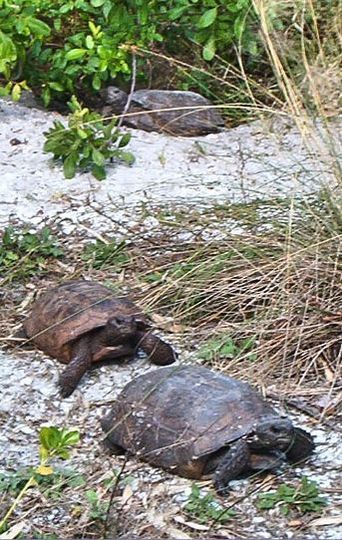
GOPHER TORTOISE CONSERVATION TEAM
Did you know that gopher tortoises are ancient? Their ancestors are a species of land tortoise that originated in western North America some 60 million years ago.
The late Ray Ashton of the Ashton Biodiversity Research & Preservation Institute said in his literature for the Gopher Tortoise Conservation Initiative, “think of them as a cow with a shell. They graze on vegetation just like cows, and therefore, are important players in spreading seeds.”
In 2006, GTCT members met with Mr. Ashton and FWC Wildlife Biologist Matt Singer to train for certification as gopher tortoise relocation specialists.
Our Gopher Tortoise Conservation Team now holds a Florida State Gopher Tortoise Agent permit, and the all-volunteer team is authorized to work under it. This permit gives them the authority to advise and perform activities associated with gopher tortoises anywhere in the state.
Their services are free of charge to island residents. They can expedite the permitting process from the FWC for homeowners, and save homeowners hundreds of dollars by performing the same relocation services that other specialists charge for.
The GTCT also responds to calls for things like injuries, mortalities, excavations, and roping off burrows for construction and for outdoor events like Art in the Palms.
Did you know that gopher tortoises are ancient? Their ancestors are a species of land tortoise that originated in western North America some 60 million years ago.
The late Ray Ashton of the Ashton Biodiversity Research & Preservation Institute said in his literature for the Gopher Tortoise Conservation Initiative, “think of them as a cow with a shell. They graze on vegetation just like cows, and therefore, are important players in spreading seeds.”
In 2006, GTCT members met with Mr. Ashton and FWC Wildlife Biologist Matt Singer to train for certification as gopher tortoise relocation specialists.
Our Gopher Tortoise Conservation Team now holds a Florida State Gopher Tortoise Agent permit, and the all-volunteer team is authorized to work under it. This permit gives them the authority to advise and perform activities associated with gopher tortoises anywhere in the state.
Their services are free of charge to island residents. They can expedite the permitting process from the FWC for homeowners, and save homeowners hundreds of dollars by performing the same relocation services that other specialists charge for.
The GTCT also responds to calls for things like injuries, mortalities, excavations, and roping off burrows for construction and for outdoor events like Art in the Palms.
|
Fun FACTS about Gopher Tortoises
Tortoise burrows can be up to ten feet deep and 40 feet long, and are as wide as the length of the tortoise that made it. The gopher tortoise shares its burrow with more than 350 other species, including indigo snakes, Florida mice, gopher frogs, opossums, rabbits, armadillos, lizards, toads and burrowing owls. The gopher tortoise reaches sexual maturity between 12 and 15 years of age, when their shells are about 9 inches long. The gopher tortoise egg's are round and about the size of a ping-pong ball. They incubate for about 80-90 days. The sex of the offspring is determined by the temperature of the sand or dirt where the nest is incubating, if the temperature is above 86° F, the tortoises hatchling will be females. Temperatures below 86° produce males. The largest part of their diet consists of low-growing grasses and legumes. They also eat gopher apple, prickly pear cactus, paw-paws, blackberries, saw palmetto berries, and other seasonal fruits. Gopher tortoises will also scavenge and are opportunistic feeders, occasionally feeding on dead animals or excrement. Most of the water they get comes from the food they eat. During periods of extreme drought they have been seen drinking standing water on the side of the road. Gopher tortoises can use their front flipper-like legs to dam up water as it runs down their burrow during a rain. A gopher tortoise may have one to three burrows in it’s home range, the area where it spends most of its time. The tortoise may travel 2 to 5 miles to forage, staying temporarily in an existing burrow or digging a new burrow. After a period of time, the tortoise may return to its original home range, and even to its original burrow. |
